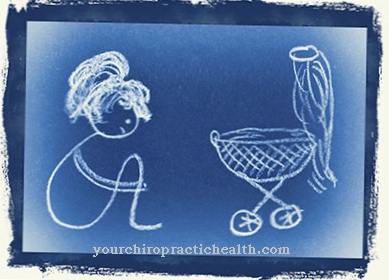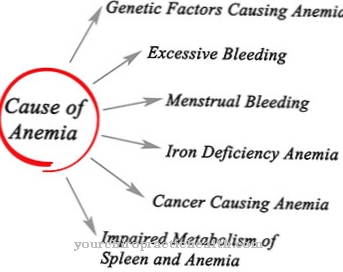Of the Bedside test is a blood group determination directly at the patient's bedside, without sample material being sent to a laboratory.
The procedure is mandatory for every doctor before a blood transfusion, in order to prevent any mix-ups of blood products. The test serves to directly compare the blood group of the potential recipient with the consistency of the canned product intended for use, which has already been classified in the laboratory and labeled accordingly.
What is the bedside test?
The principle of the bedside test was invented by the American doctor and hematologist Reuben Ottenberg (1882-1959), who introduced special tests of blood tolerance into practice in 1907.
The test, which is still common today, is carried out on a small card that has two or three test fields with anti-A, anti-B and possibly anti-D serum. A drop of blood is placed on each field and distributed there with a special plastic stick. This means that the blood group in the so-called AB0 system and the Rhesus factor can be reliably tested. For example, blood of blood group A with Rhesus factor will agglutinate (clump) positive on the anti-A and anti-D fields, while it remains unchanged in anti-B.
On the Anti-B field, drops of blood from groups B and AB clump together, while blood from groups A and 0 does not change. In order to avoid incorrect determinations, each individual serum is assigned to the colors commonly used in the laboratory. The test field with anti-A serum is generally colored blue, that with anti-B serum yellow. The test result is documented long-term in the patient card; the test card with the dried blood drops is destroyed after a few days for hygienic reasons. According to the relevant blood groups, the procedure is also called the AB0 identity test.
Function, effect & goals
Agglutination is the result of mixing two or more blood groups that do not match. The human body rejects what it does not know, so foreign blood of a different blood group than the body's own clots.
This intolerance results from the various protein substances that are in each blood group. The proteins are labeled A and B as well as the Rhesus factor. Blood group A rhesus positive (A +) means that protein A occurs in the blood and positive evidence for the rhesus factor is given. Rhesus negative means that this protein is not present in the specific blood group. Anyone who belongs to blood group AB Rh-positive therefore has all three proteins. In contrast, group 0 Rhesus negative lacks all known protein groups in the blood.
Therefore this blood group can be used universally as donor blood for emergencies. However, all other blood types must match when transferring blood from a donor to a recipient. The bedside test can be used to determine immediately before a transfusion whether this match is actually given. In order to rule out all risks as far as possible, both the recipient blood and the donor blood are usually examined with the bedside test.
Risks, side effects & dangers
All types of transfusion blood in question have to be subjected to the test, including and especially the often used red blood cell and granulocyte concentrates.
The bedside test is also mandatory in an emergency when the patient's life is at risk. The patient's blood must always be drawn directly on site. Recourse to stored blood samples of the patient of any kind is categorically excluded. Even when transfusing autologous blood, patient and canned blood must always be freshly subjected to the bedside test. Immediately after the test has been carried out, a detailed comparison of the blood data collected from the recipient and the donor must be made. In the event of the slightest deviations, the upcoming transfusion process must definitely be abandoned.
If several transfusions are carried out one after the other, the bedside test must be repeated for each individual transfusion. This also applies to any change in the medical and medical personnel involved. In addition, the bedside test must always be taken personally by the transfusing doctor. The doctor may not delegate its implementation to any other person. If he wants to teach the test to a less experienced colleague, the transfusing doctor must be under direct supervision.
The greatest possible caution and attentiveness in connection with blood transfusions are necessary because there are extremely diverse possibilities for confusion and in the past they have repeatedly become a reality that no transfusing doctor can overlook. The mix-ups can arise during the blood collection and extend to mixed-up canned goods on a ward or in the operating theater. In all of these cases there can be serious consequences for recipients of blood reserves, which are often life-threatening. For these reasons, the various conventional bedside test methods are constantly being put to the test.
Imponderables are primarily associated with the sticks with which the drops of blood are placed on the test fields of the small cards with the serum samples. In a newly developed process, the blood is applied to the respective antiserum with the aid of a syringe with a cannula through an elastic cover sheet. Because the foil tightly encloses the needle, it is guaranteed that neither blood nor serum are carried away or can get into other test fields. In addition, the small opening in the film is closed again immediately after the puncture. After shaking, the reaction of the blood with the serum can be felt immediately. This modern form of bedside test only takes a maximum of ten seconds. This short period of time can be invaluable to the patient in emergency situations.













.jpg)











.jpg)


